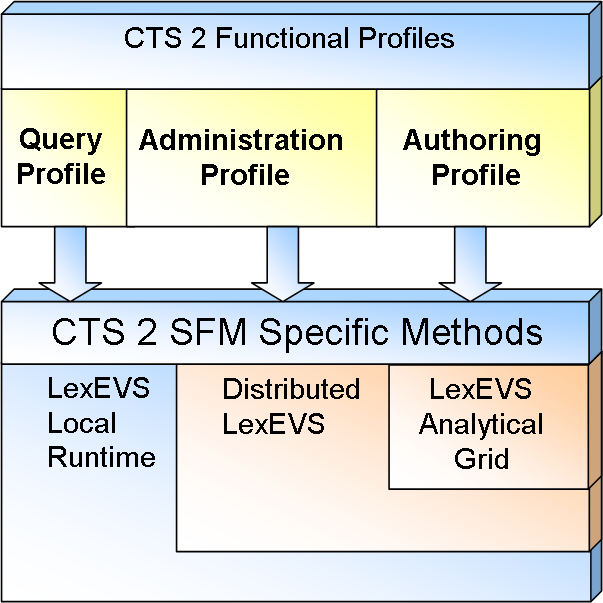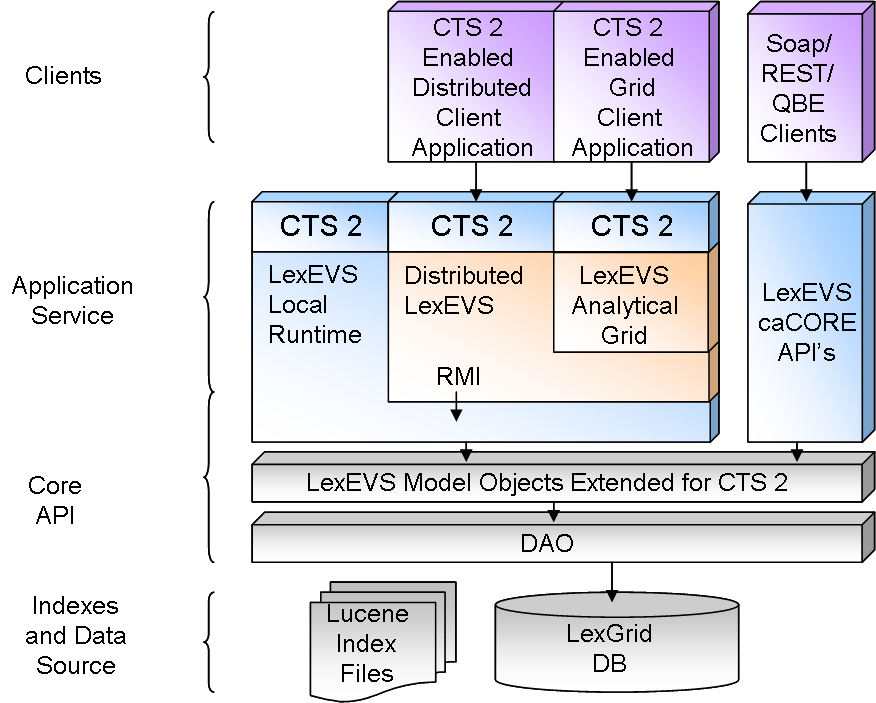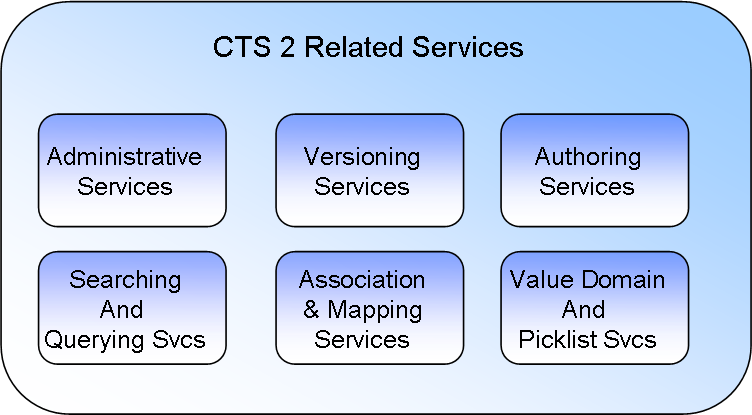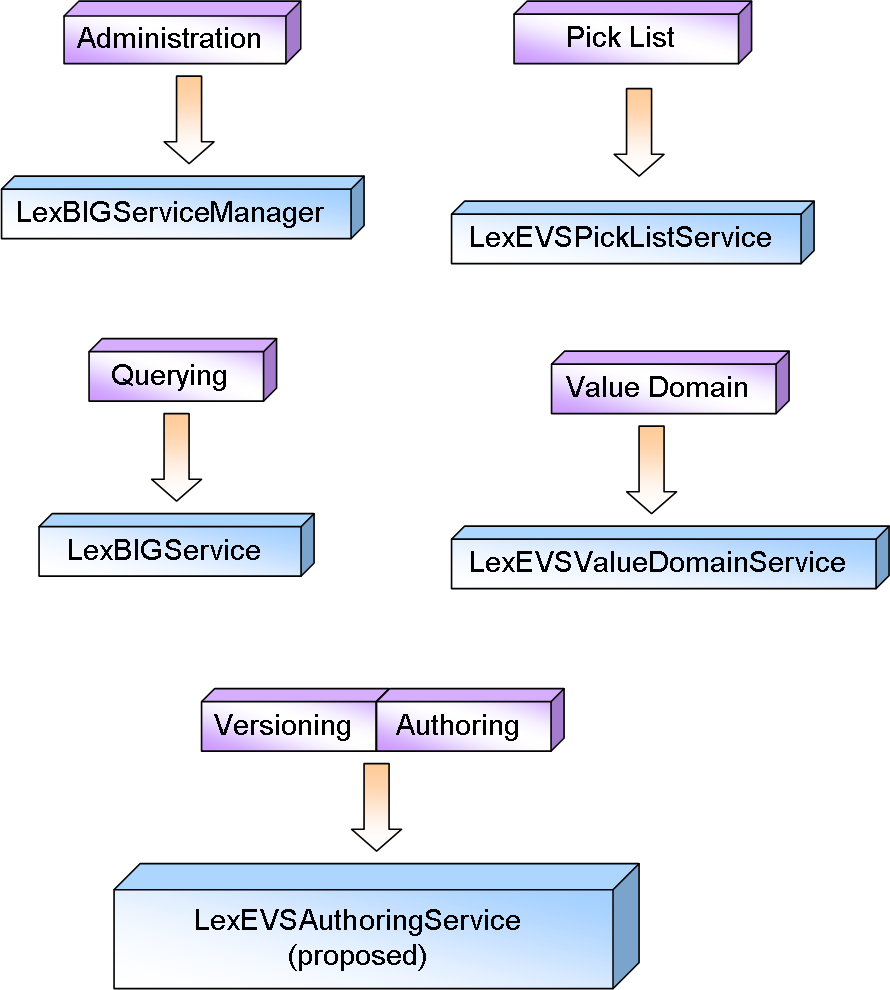"
Author: Traci St.Martin/Craig Stancl
Email: stancl.craig@mayo.edu
Team: LexEVS
Contract: [Contract number]
Client: NCI CBIIT
National Institutes of Heath
US Department of Health and Human Services
Sign off |
Date |
Role |
CBIIT or Stakeholder Organization |
Reviewer's Comments (If disapproved indicate specific areas for improvement.) |
|---|---|---|---|---|
|
|
|
|
|
|
|
|
|
|
|
|
|
|
|
Solution Architecture
Proposed technical solution to satisfy the following requirements:
- Provide support for Value Sets.
- Develop within LexEVS the ability to provide local extensions to code sets and maps among code sets.
- Develop within LexEVS other capabilities called for in the CTS2 Specification.
Required CTS 2 Functionality
The required LexEVS functionality to support CTS2 addresses several broad categories.
Administrative Operations
Import Operations The CTS2 SFM calls for the ability to import code systems, code system revisions, value set versions and association versions. The current LexEVS model does not differentiate between the importation of a complete code system and an incremental update in the form of a code system revision, but the functionality is sufficient to fully meet the requirements of both operations. Note, however, that the incremental update functionality of LexEVS has not been fully implemented as of version 5.1, and will need to be completed in order to meet these requirements. The import of association versions will be also be absorbed as part of the code system revision functionality. The current LexEVS implementation already supports the import of value domain definitions, although incremental updates still need to be provided.
Export Operations The CTS2 SFM calls for the ability to export code systems, associations and value sets. The current LexEVS implementation supports the ability to export complete code systems in LexGrid XML and OBO formats. At the moment, it does not support the ability to export value domain definitions or pick lists. The CTS2 SFM also calls for the ability to provide filter criteria in the exports although the use and functions of such filters are not totally clear.
While the SFM does not spell a minimal set of export requirements, we believe that it will be necessary to support LexGrid XML, RDF / OWL and, when appropriate, as an exact image of the original source. We also believe that there are use cases that will require the ability to export a set of changes as a "delta" from a previous version - a set of changes that can be applied to another image that will supply the appropriate update.
Code System Status Changes The current LexEVS implementation already supports a superset of this functionality.
Notification While the need to support notification has been anticipated in the current LexGrid architecture, it has not been completely modeled or implemented. Analysis, however, has identified a set of requirements that extend beyond the basic ones identified in the CTS 2 SFM. As an example, a use case was identified where an administrator needed to be notified when the contents of a concept that was referenced by a value set changed.
Architectures and corresponding implementations for notification and event generation already exist. While it will be necessary to tie these events in to the LexEVS implementation, we do not plan to implement any of the notification tooling directly but, instead will implement it in such a way that it can be tied into a standards compliant event and messaging architecture.
Search and Query Operations
Code Systems LexEVS already implements a superset of the code system search and access requirements with the exception that search criteria and the "query control" aspects are combined as a single operation.
Value Sets The CTS2 SFM calls for the ability to list value sets, return value set details and list value set contents. It also calls for a determination of value set subsumption and queries about concept membership. The current LexEVS implementation supports all of these functions with the exception of value set subsumption. It should be noted, however, that there are two possible interpretations of "subsumption" - an extensional and intensional subsumption. Testing extensional subsumption determines whether one value set subsumes another based on their current resolutions. Testing extensional subsumption, however, is more difficult, as it involves the determination whether subsumption is necessary. We intend to implement the former. We also intend to postpone the implementation of the "value override" element in the value set construction pending further clarification of the use case.
Concept Domains and Usage Contexts The HL7 notion of "Concept Domain" was originally architected to align with the ISO 11179 Enumerated Conceptual Domain. It has since evolved, however, to be a more abstract entity that, if anything, is closer to the ISO 11179 Data Element Concept. The CTS SFM shows the role of Concept Domain as coupling a value set with a set of designations. While LexEVS supports this particular functionality through pick list implementation, we are not certain that this model will meet all of HL7's needs, as HL7 Edition 3 views concept domains as controlling the coupling of data elements with particular enumerated conceptual domains.
As mentioned earlier, we intend to model concept domain, usage context and jurisdictional domain as code system entities instead of making them first class model elements. The concept domain binding and concept to concept domain functionality is partially implemented in the LexEVS pick list model, but will need additional modeling and development to provide the full functionality required by the SFM.
Association Related Queries The CTS2 SFM calls for the ability to enumerate associations, compute the transitive path between two concept codes, determine whether one coded attribute is subsumed by another and return the details of an association. Some of the requirements are a bit unclear on whether they are calling for the ability to query association types or the actual set of associations (relation) coupled with the type. LexEVS provides a rich set of functionality to perform the latter and provides all of what we believe to be necessary to support the former. Transitive closure is available, but we will probably want to expose it as a helper function.
Full subsumption queries imply the use of a reasoner. We see this as a non-trivial task, as the different terminologies are based on different types of description logics and, even within the same family of description logic there are different algorithms that can produce different results based on completeness requirements. The LexEVS package does not currently support (a) reasoners and (b) the ability to supply a pre-coordinated expression as either the input or output of a function. We will postpone the implementation of compositional expression pending the clarification of whether LexEVS can or should support formal reasoning.
Tasks:
- Implement value set subsumption queries
- Extend model and implement concept domain, usage context and jurisdictional domain and associated queries.
- Implement transitive path query convenience function.
Authoring and Curation Operations
"Authoring" and "incremental update" are closely related notions, but there is an important distinction between them. Incremental update, as specified in the current version of the LexEVS model, assumes that any set of changes will transform the underlying entity (code system, value domain, pick list) from one consistent state to another. Authoring, however, requires an additional ability to save entities in states that are neither valid nor complete. The current LexGrid architecture and model is based on the premise that the information being provided is valid and consistent and is not designed to support partially formed artifacts such as concepts without associated codes, associations that have a source but no target, etc.
The proposed responses to the authoring tasks below assume that there is an external authoring tool that persists partially formed content and performs the necessary validation and reasoning tasks prior to their being incrementally loaded into the LexEVS services. We see this as being a necessary separation, as the potential combination of editors, reasoners, terminology models, etc. is almost limitless, and each of these will have its own requirements when it comes to completeness and validity.
Code System Authoring and Curation The CTS2 SFM calls for the ability to create, maintain and update code systems, concepts, and associations as separate entities. The LexGrid and LexEVS model views all three of them as aspects of code systems, and its incremental revision approach allows any or all of them to be changed as a single unit. The LexEVS model also subsumes the notion of a "code system supplement", as a collection of one or more revisions to a code system can be packaged as a "system release", with its own provenance, activation dates, etc., and can be applied to external code systems independently.
Tasks:
- Complete the LexEVS incremental update functionality.
High Level Architecture
Structure of the CTS 2 Service
The functional CTS 2 Model defines several functional profiles. These profiles are a focused subset of the functionality of a CTS 2 implementation.
CTS 2 Query Profile:
- Searching and querying terminologies
- Provide access to terminology content and representational structures (description logic) consistent with the terminology author's intent.
Terminology Administration Profile:
- Restricting administrative access
- Obtaining and loading terminologies
- Maintaining terminology access
- Control Content Access
Terminology Authoring Profile:
- functional terminology analysis/query
- direct terminology edits
Semantic Profiles
HL7 Profile:
- Functional coverage and specificity necessary for HL7 conformance
- Searching terminology content
- Interchange content in the the Model Interchange Format.
- Use of HL7 Datatypes
- (Model Interchange Format (MIF) Representation of terminology content
Mature Terminology Profile:
- Best practices conformance for the terminology
Developing Terminology Profile:
- ad hoc or degraded terminologies
High Level Design Diagram
CTS 2 Functional Profiles
CTS 2 Query Profile
List Code Systems |
The ability to provide a listing of the available code |
Return Code System Details |
The ability to retrieve a specific code system attributes |
List Code System Concepts |
The ability to retrieve a list of all of the concepts, |
Return Concept Details |
The ability to retrieve a specific concept, with |
List Value Sets |
The ability to determine what value sets are available to |
Return Value Set Details |
The ability to retrieve a specific value set, with |
List Value Set Contents |
The ability to see a listing of specific concepts, as well |
Check Concept Value Set Membership |
The ability to validate that a given concept exists in a |
List Concept Domains |
The ability to determine what concept domains are |
Return Concept Domain Details |
The ability to retrieve a specific concept domain, with |
List Concept Domain Bindings |
The ability to see a listing of specific value sets that |
Check Concept Domain Membership |
The ability to validate that a given concept code is bound |
List Usage Contexts |
The ability to determine what usage contexts are available |
Return Usage Context Details |
The ability to retrieve a specific usage context, with |
List Associations |
The ability to determine what associations are available |
Return Association Details |
The ability to retrieve metadata on available associations |
List Association Types |
Returns the details for the known attributes (metadata) of |
Return Association Type Details |
The ability to return all information for a Association |
Check Value Set Subsumption |
Determine whether one of the two supplied value sets |
Check Concept to Concept Domain Association |
Determine whether the supplied coded concept exists in a |
Determine Transitive Concept Relationship |
Determine whether there exists a transitive relationship between two |
Compute Subsumption Relationship |
Determine Whether One Concept Subsumes a Second |
Terminology Administration Profile
Import Code System |
Terminology content would be loaded into the terminology |
Import Code System Revision |
Terminology content would be loaded into the terminology |
Import Value Set Version |
Ability to import values sets |
Import Association version |
Ability to import Associations |
Export Association |
Ability to export Association Type instances |
Export Code System Content |
Terminology content would be exported either in whole or |
Change Code System Status |
Terminology content status would be changed, thus changing |
Register for Notification |
A client registers for notification so that an electronic |
Update Notification Registration |
Subscription notification information can be updated for a |
Update Notification Registration Status |
Updates the status of a notification registration. |
Terminology Authoring Profile
Create Code System |
The ability to create a new Code System to contain a set |
Maintain Code System Version |
The ability to maintain the content and metadata of a |
Update Code System Version Status |
The ability to modify the status of a code system. |
Create Concept |
The ability to define and add a new concept to a code |
Maintain Concept |
The ability to modify a concept that exists in a code |
Update Concept Status |
The ability to modify the status of a concept that exists |
Create Value Set |
The ability to create a dynamic value set that is defined |
Maintain Value Set |
Update properties or expression of a value set definition |
|
|
Update Value Set Status |
The ability to modify the status of a value set. |
Create Concept Domain |
The ability to define and add a new concept domain. |
Maintain Concept Domain |
The ability to modify a concept domain, including bindings |
Create Usage Context |
The ability to define and add a new usage context. |
Maintain Usage Context |
The ability to modify a usage context. |
Terminology Administration Profile |
The Terminology Administration profile is intended to |
Create Association |
The ability to create an association between concepts. |
Update Association Status |
The ability to update the status of an association between |
Create Association Type |
The ability to create a new Association type that may be |
Maintain Association Type |
The ability to modify or deprecate an existing Association |
Create Lexical Association Between Coded Concepts |
The ability to instantiate an association between two sets |
Create Rules Based Association Between Coded Concepts |
The ability to instantiate an association between two sets |
Create Code System Supplement |
Create a new Code System Supplement as a container of a |
Maintain Code System Supplement |
Update Code System Supplement meta-data properties and add |
A Sub Categorization of Services
CTS Services can be further categorized from the profile details above:
CTS Service Interfaces
Solution Architecture
Data Access Layer
LexEVS lacks a generalized Read/Write interface that can support Authoring and incremental Coding Scheme changes. Also, database access is not isolated. Database-specific code is intermixed with the Service Layer, as well as Extensions. To make LexEVS more able to handle Authoring, while at the same time providing a clean, centralized Database Access Layer, these are the requirements:
- Service Layer code should not call any JDBC code other than a Data Access Interface
- The Data Access Layer should allow connection pooling
- The Data Access Layer should expose 'Service' or 'Repository' Interfaces to the Service Layer.
- Transactions should be well defined
- Allow for Backwards Compatibility
- Inserts, Updates, Selects, and Deletes should cascade the Object hierarchy if desired
- Service-Exposed Interfaces should use the Castor-generated beans.
- Batch inserts should be supported
- Lucene access should be included in the Data Access Layer
- Registry accesss should be included in the Data Access Layer.
- Expose an Event-Driven framework to allow users to insert business rules to control access to the database
- In terms of System Resource responsibilities, the Data Access Layer should be responsible for:
- Detecting the LexGrid Schema version
- Detecting the Database Type (MySQL, Oracle... etc)
- Producing appropriate implementations of the Database Access code given the above
- Loading and initializing all schemas on install
- Tracking loaded Coding Schemes and other resources
- All database admin functions (remove Coding Scheme, index, compute transitivity, etc)




